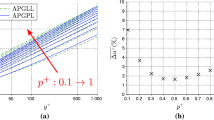Abstract
The complex turbulent flow behind a backward-facing step is modelled using a full Reynolds stress closure. In order to develop a closure model that can resolve the complex near-wall flow in the recirculation region and in the recovery region downstream of the reattachment point, the performance of a low and a high Reynolds number version of the full Reynolds stress closure is examined and compared. Furthermore, the effects of redistribution modelling on the calculated flow is studied by comparing the performance of three redistribution models: one return-to-isotropy model and two with mean-strain effects. The results are grid independent and show that the flow downstream of the step is best described by a low-Reynolds-number model that does not depend on the conventional wall function assumption. However, the skin friction behavior is correctly predicted by the stipulation of a wall function. Of the three redistribution models examined, the return-to-isotropy model gives results that are in excellent agreement with measurements. Finally, the calculated results are adversely affected by refining the redistribution models to include meanstrain effects.
Similar content being viewed by others
References
P. Bradshaw and F. Y. F. Wong,The reattachment and relaxation of a turbulent shear layer. J. Fluid Mech. 52, 113–135, (1972).
S. J. Kline, B. J. Cantwell and G. M. Lilley,The 1980-81 AFOSR-HTTM-Stanford Conference on Complex Turbulent Flows: Comparison of computation and experiment 2. Thermocsci. Div., Stanford University, Stanford, California 1982.
D. W. Etheridge and P. H. Kemp,Measurements of turbulent flow downstream of a reward-facing step. J. Fluid Mech.86, 545–566 (1978).
B. E. Launder and D. B. Spalding,Mathematical Models of Turbulences. Academic Press, London, 57–60 (1972).
M. M. S. Sindir,A numerical study of turbulence flows in backward-facing step geometries: A comparison of four models of turbulence. Ph.D. Thesis, University of California, Davis, California 1982.
M. C. Celenligil and G. I. Mellor,Numerical solution of two-dimensional turbulent separated flows using a Reynolds stress closure model. ASME Paper No. 85-WA/FE-5 (1985).
J. Kim, S. J. Kline and J. P. Johnston,Investigation of separation and reattachment of a turbulent shear layer: flow over a backward-facing step. Thermosci. Div., Rept. MD-37, Stanford University, Stanford, California 1978.
R. V. Westphal, J. K. Eaton and J. P. Johnston,A new probe for measurement of velocity and wall shear stress in unsteady, reversing flow. J. Fluid Eng.103, 478–482 (1981).
J. K. Eaton and J. P. Johnston,Turbulent flow reattachment: An experimental study of the flow and structure behind a backward-facing step. Thermosci. Div., Rept. MD-39, Stanford University, Stanford, California 1980.
W. H. Stevenson, H. D. Thompson and R. R. Craig,Laser velicometer measurements in highly turbulent recirculating flows. J. Fluid Eng.106, 173–180 (1984).
B. E. Launder, G. J. Reece and W. Rodi, Progress in the development of a Reynolds-stress turbulence closure. J. Fluid Mech.68, 537–566 (1975).
K. Hanjalic and B. E. Launder,A Reynolds stress model of turbulence and its application to thin shear flows. J. Fluid Mech.52, 609–638 (1972).
A. N. Kolmogorov,The local structure of turbulence in incompressible viscous fluid for very large Reynolds numbers. C. R. Akad. Nauk. SSR30, 301–305 (1941).
M. M. Gibson and B. A. Younis,Calculation of swirling jets with a Reynolds stress closure. Phys. Fluids29, 38–48 (1986).
W. Kebede, B. E. Launder and B. A. Younis,Large amplitude periodic pipe flow: A second moment closure study. Proc. 5th Turbulent Shear Flows Symposium, Paper No. 16 (1985).
R. M.C. So and G. J. Yoo,On the modelling of low-Reynolds-number turbulence. NASA CR-3294 (1986).
R. M.C. So and G. J. Yoo,Low-Reynolds-number modelling of turbulent flows with and without wall transpiration. To appear in AJAA J. (1987).
J. C. Rotta,Statistische Theorie nichthomogener Turbulenz. Z. für Physik129, 547–572;131, 51–77 (1951).
K. Y. Chien,Predictions of channel and boundary layer flows with a low-Reynolds-number two-equation model of turbulence. AJAA J.20, 33–38 (1982).
S. V. Patankar and D. B. Spalding,A calculation procedure of heat, mass and momentum transfer in three-dimensional parabolic flows. Int. J. Heat Mass Transfer15, 1787–1806 (1972).
Author information
Authors and Affiliations
Rights and permissions
About this article
Cite this article
So, R.M.C., Lai, Y.G., Hwang, B.C. et al. Low-Reynolds-number modelling of flows over a backward-facing step. Z. angew. Math. Phys. 39, 13–27 (1988). https://doi.org/10.1007/BF00945719
Received:
Revised:
Issue Date:
DOI: https://doi.org/10.1007/BF00945719




